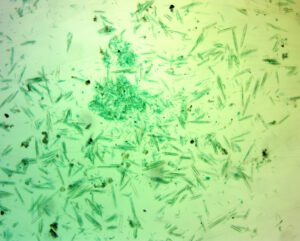Not long ago, I read an article about algae that was adapted from a book called Lake Watch: A Guide to the Care of the Yahara Lakes, written by several distinguished authors from the University of Wisconsin. I thought I would share with you some of the information gleaned from that article.
What is / are Lake Algae?
My first question for you: is the word algae singular or plural. Is it perhaps both? I always thought it was singular, but the article I read indicates plural. The answer is perhaps not as important as the function that these little organisms serve.
Even though they are responsible for making swimming in your favorite lake a little difficult – simply because of the distinct green color and tiny floating green things in the water – the lake would not be a very happy place without them. And for the fisherman in all of us, know that the “lowly” algae are very important. They are at the very base of the aquatic food chain. Without them, there would be no fish! By the way, algae are primitive plants.
There are literally hundreds of species of the culprits in question – the ones found floating and suspended in the water. They are called phytoplankton and at a minimum, they affect the clarity of the water.
Seasonal Changes
Obviously, throughout the year, conditions change on any lake. Seasonal changes bring corresponding changes in the air and water temperature, amount of light and nutrients to the lake. The changes favor various species of algae at various times, which, as they become abundant, affect not only the clarity of the water but the color as well.
The algae swim about (plants that swim!) by means of long, hair-like appendages called flagella. Only a small number survive in the winter months, swimming just beneath the ice and capturing the weak sunlight that is able to penetrate. The water in the lake is very clear at this point.

Diatoms
As the days lengthen in the springtime, the ice melts. But other changes are also afoot. Spring storms stir the waters again, bringing from the bottom of the lake the spores of another species of algae, the diatoms. These long-dormant organisms come to life in the light of the nutrient-rich waters and begin to reproduce.
The diatoms are extremely tiny yet ornate; a spring “bloom” of them can turn the lake water brown in a matter of only a few days. The watercolor is due to a pigment that makes the diatoms appear brown in the same manner that chlorophyll makes the leaves on a tree green.
In the calmer days of early to mid-summer, the diatoms produce the spores that once again settle to the lake bottom. The diatoms’ decline makes way for the green algae. Green phytoplankton don’t really get a chance to dominate the scene, since they make a great meal for another species of microscopic animal called Daphnia.
Blue-Green Algae
By now – midsummer – the species referred to as blue-green algae get the upper hand. They thrive in warm, still water because many of them can manufacture the nitrogen that they need right from the atmosphere. They can also reproduce at a phenomenal rate… often turning your favorite swimming hole into an ominous pea soup-looking mess in short order.
The blue-greens don’t sink out of sight like the diatoms, and they are not the favorite meal of many species – like the Daphnia – so they tend to hang around for most of the rest of the summer. Worse, as they die and decay, they can be blown to shore to create a stinky and unsightly scum along the shore line.
But there is some very good news in all of this. The decay of these organisms releases needed nutrients back into the water. And, as the summer heat yields to the onset of the cooler temperatures of the fall, the cooler waters also cause the majority of the blue-green population, as well as the shore scum, to disappear.
Another Cycle Begins
The lake “turning over” is simply the winds of autumn recalling the diatoms from the depths. The warm and oxygen depleted waters near the surface are replaced with the nutrients from below while the storms and wind can whip life-giving oxygen into the waves once again, and the cycle of life is ready to begin anew.
We take many things in the waters for granted, but some of the most important processes are undertaken by organisms too small to be seen or appreciated.
As always, I hope to see you On the Lake!
rk